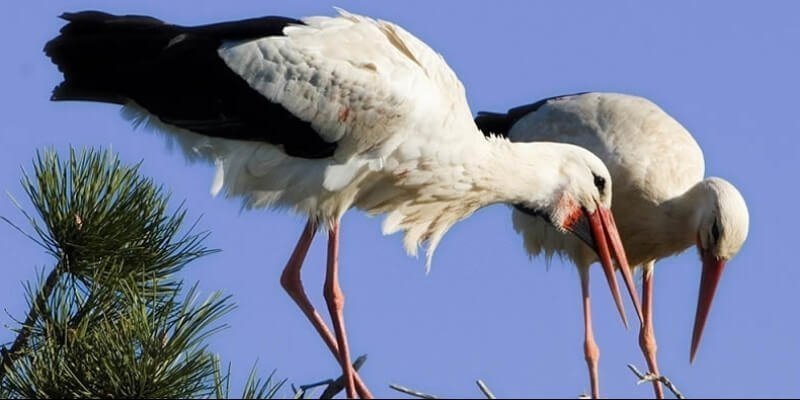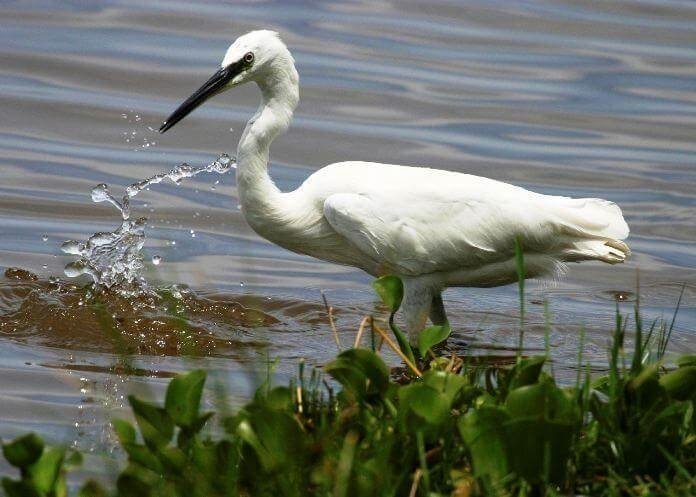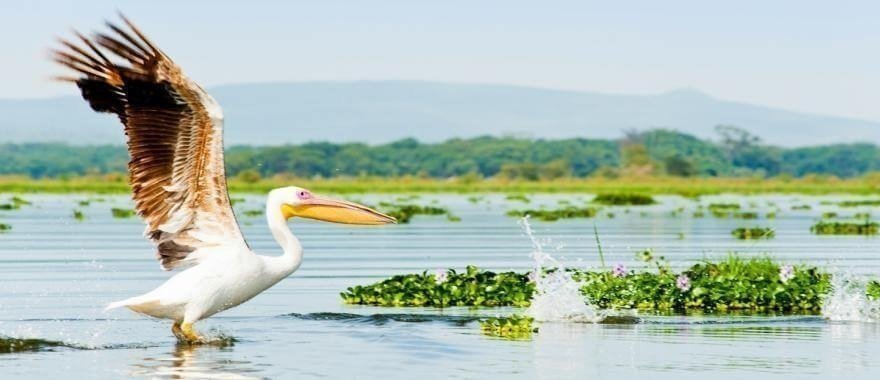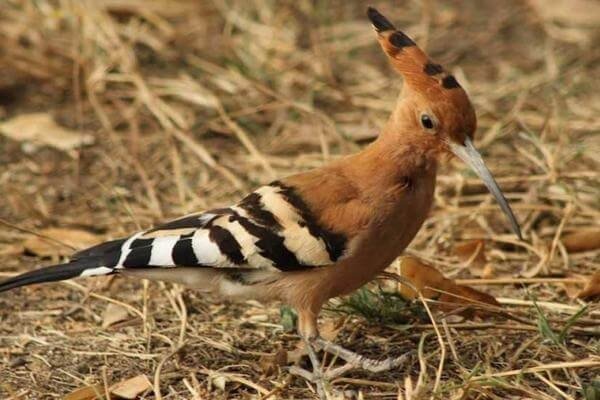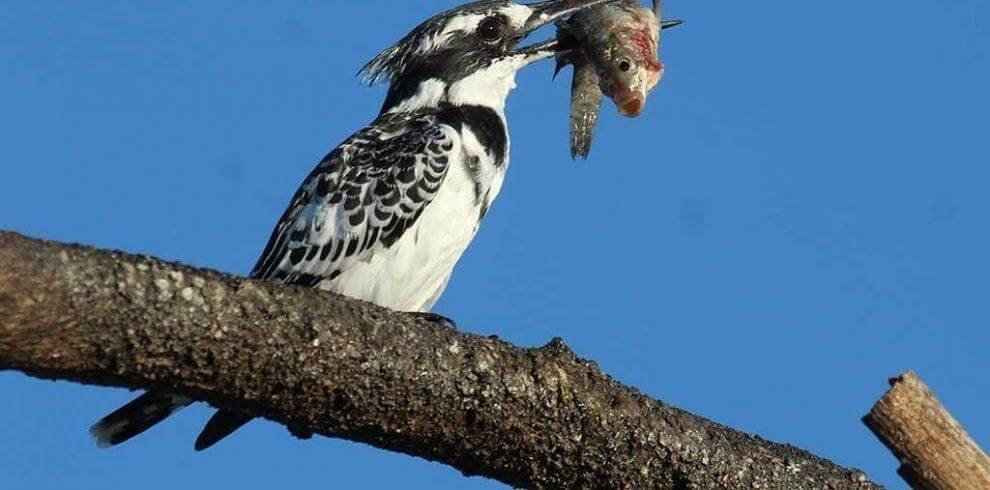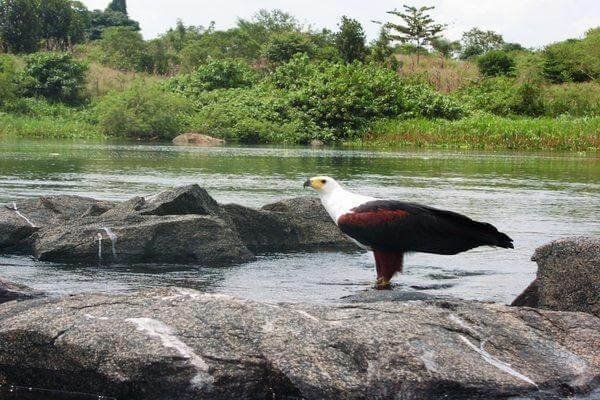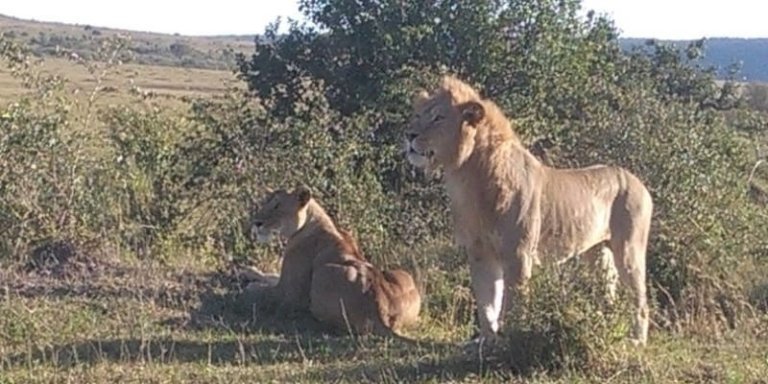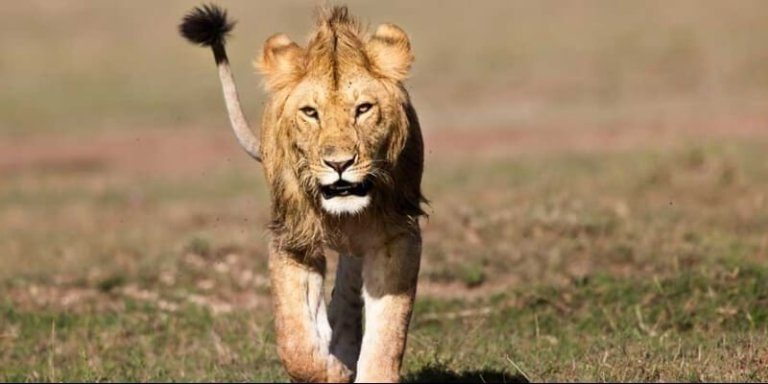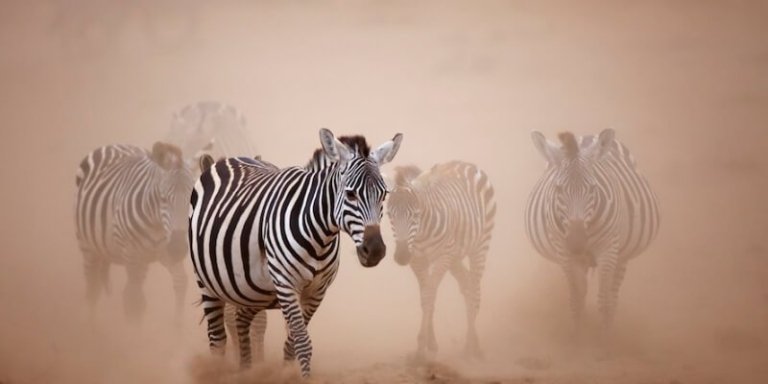An action packed Kenya Wildlife Adventure Safari is all inclusive tour package, staring from Nairobi city with a stop over at the view point en route to the Lake Nakuru National Park to Naivasha and Read more ➤
Africa Bird Watching & Wildlife Safari - 19 Daya
-
Duration - 19 days, 8 hours, 30 minutes
-
Guide optionsEnglish
-
Cancellation PolicyStandard
Overview
This 19 days Africa Bird Watching Wildlife Photography Kenya safari takes you to, Nairobi National Park, Mount Kenya National Park, Lake Naivasha, Lake Baringo, Lake Nakuru, Kongelai Escarpment, Kakamega Forest, Lake Victoria & Masai Mara National Park.
Highlights
- This a typical Birds watching itinerary, where you will have the opportunity to watch over one thousand bird species, beautiful landscapes and thousands of other wild animals.
- Naivasha with different habitats: fresh water lake, open savanna grasslands and acacia woodlands presents an opportunity to record a high number of Kenya birds species in a very relaxed way.
- Lake Nakuru is not only for flamingos but also for numerous species of water birds. Masai Mara, the last section of this birding tour will not only be for birds but also for excellent game viewing
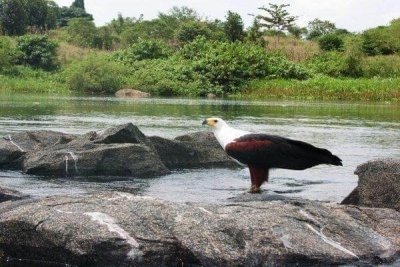
Description
Africa Bird Watching & Wildlife Safari
Kenya offers Africa in a nutshell, from the soda-encrusted, flamingo-filled Rift Valley lakes to alpine Mt. Kenya and the western lowland forests at Kakamega. These habitats, combined with bird-rich savannas, Tsavo’s semi-deserts, Sokoke’s coastal forests, and of course, the parks that make it the world’s premier big mammal watching destination, make Kenya a perennial favorite in Africa. This is not surprising when you consider you will probably see more bird and mammal species than any other African tour.
Most of this tour (apart from the extension) is above 3000 feet elevation, making the climate surprisingly pleasant, far from the blistering heat that some people may expect from equatorial Africa.. This program is best suited for those who have an ornithological appetite. The itinerary will take you the places that are rich in avian species of all kinds from the wading birds of Lakes Baringo, Bogoria, Nakuru and Victoria, the bush birds of Lake Baringo and Lake Nakuru, to the forest birds of Kakamega forest.
Each destination has a distinctive bird population with several endemic species. Kenya is one of the top birding destinations in the world; with over 1089 different bird species recorded (around 11 percent of the world total bird species), is no doubt a heaven for bird lovers.
Major birding is done along the Great Rift Valley alkaline lakes, the rainforests, rivers and the semi-arid desert that provide great conditions for birds foraging and breeding. Check out some of our sample birding packages below or contact one of our holiday experts, to plan your birding tour in Kenya.
What's included
- Inclusions:
- • All Transport Excluding Fights • Services of a well trained safari guide
- • All Park entry fees • All Accommodation
- • Pick up from hotel to safari destinations and back to hotel • Boat Trips
- Exclusions:
- International air transportation to and from Nairobi
- Expenses of personal nature such as visas, travel/baggage insurance, laundry, beverages, tips
- Entry fee to local masai village (USD $30 per person per entry) Balloon safaris (USD $450)
Itinerary
- Visited Places:
Day 1: Arrival On arrival at the Jomo Kenyatta International Airport, Destinations Kenya Safari representative receives you for your 19 days Kenya Bird Watching Wildlife Photography Safari. You will be transferred to the hotel for check in, depending on the time of arrival; we visit the National Museum Bird BLOG and later have a leisurely bird walk in the Nairobi National Museum Botanical Gardens. Overnight at Nairobi Safari Club (Full Board) Day 2 Nairobi National Park After an early morning breakfast, we go birdwatching to Nairobi National Park. Nairobi National Park has a diverse avifauna with checklist of over 520 bird species. One of the eight species of Kenya Mountains Endemic Bird Areas, 27 species of the 94 Somali-Masai biome, and 25 species of the 67 African Highlands biome that occur in Kenya, have been recorded in the area. Migrating Lesser Falcons roost at the site in large numbers (Over 5,000 individuals have been recorded at a time), and the park's substantial area of undisturbed grassland is of great importance for species such as the restricted-range Jackson's Widowbird, which breeds here regularly after good rains. The globally threatened Corncrake, Madagascar Pond-Heron, Lesser Kestrel, Corncrake, Jackson's Widowbird, Red-throated Tit and the near threatened Shoebill Stork and Basra Reed Warbler have both been spotted. We look out for those unique species. Overnight at Nairobi Safari Club (Full Board) Overnight at Nairobi Safari Club (Full Board) Day 3: Nairobi National Park We search for the African Silverbill, Red-winged Starling, Common Bulbul, Grey-headed Sparrow, Saddle-billed Stork, Little Egret, the Common Squacco, Goliath, Grey and Black Headed Herons, Red-billed and African Firefinches, the Booted, Tawny, Steppe, and Martial Eagles, Yellow-whiskered Greenbul, Long-tailed and Common Fiscals, Spotted and Pale Flycatchers, Common Stonechat, Blackcap, Yellow-breasted Apalis, Mountain Yellow Warbler, Yellow White-Eye, White-bellied Tit, Variable Sunbird, Bronze Mannikin, Red-cheeked Cordon Blue, Streaky Seedeater, Collared Widow bird, the Zitting, Desert, Winding, Stout, Pectrol-patch, Singing and Rattling Cisticolas, Grassland Pipit, Rufouse-naped and Athi Short-toed Lark, Lesser-striped and Red-rumped and Barn Swallow, Brown Parisoma, Oliveceous Warbler, Brubru, Whinchat, the Little, White-ramped, Horus and African-palm Swifts, Quail-Finch, Common and Yellow-bellied Waxbills, African-hawk Eagle, White-headed and Spot-flanked Barbets, Baglafecht Weaver, Brown-snake Eagle, and many more; Along with a fine number of mammals among which will include; the Cape Buffalo, Burchell's Zebra, Hippopotamus, Masai Giraffe, Rhinos, Coke's Hartebeest, the Vervet and Syke's Monkey, just to mention but a few. Nairobi Safari Club (Full Board) Day 4: Mount Kenya National Park ToDay we drive birding to the important bird area named after Kenya's highest mountain.Birding Mount Kanya can be so well paying since the site has a rich montane avifauna. The park has six of the eight Kenya Mountains Endemic Bird Area and 54 of the 70 Afrotropical Highlands biome species that occur in Kenya. Mountain Kenya area has records of globally and regionally threatened species, some with no recent records. They include Abbott's Starling,Lesser Kestrel (a passage migrant on the moorland), Jackson's widowbird (at up to 3,000 m), Sharpe's Longclaw, Olive Ibis, Lammergeier, ayres's hawk-eagle, African Crowned Eagle, African Grass Owl, Cape Eagle-Owl, Purple-throated Cuckoo-shrike, Long-tailed widowbird, Abyssinian Owl (very rare and poorly researched), Scarlet-tufted Sunbird, and Kenrick's Starling which is confined to this area in Kenya. We search for these specialties along with other wildlife among which will include; Black-and-white Colobus Monkey, Sykes monkey, Bushbuck, Cape Buffalo, African Elephant, Olive Baboon, Waterbuck, Black Rhino, Leopard, Giant Forest Hog, Genet Cat, Bush Pig, Spotted Hyena and many more. Mountain Lodge (Full Board) Day 5: Mount Kenya National Park We look out for more species possibly missed the previous Day. Overnight at Mountain Lodge (Full Board) Day 6: Lake Naivasha After breakfast, we bird to the shallow freshwater lake with fringing Acacia woodland- Lake Naivasha Ramsar site (the second site listed by Kenya as a Wetland of International Importance under the Ramsar Convention). Naivasha's water is supplied by the permanent Malewa and Gilgil, plus the seasonal Karati rivers which all drain the Aberdare Mountains along with substantial ground-water seepage. The lake has no surface outlet. It is thought that a combination of underground outflow and sedimentation of salts keeps the lake fresh, unlike other endorheic lakes in the eastern Rift Valley. It is the highest of the Rift Valley Lakes at 1,880 m, the second largest freshwater lake and one of the only two freshwater lakes in Kenya. The fascinating bird life of over 350 species is supported by the availability of dense vegetation at the lake edge. Papyrus fringes the main lake's shore and cloaks the inlets of the Gilgil and Malewa rivers. Overnight at Lake Naivasha Country Club (Full Board) Day 7: Lake Naivasha After breakfast we still bird the lake and its surroundings, we look out for the globally threatened Grey-crested Helmeted-shrike, Basra Reed Warbler, Lesser Flamingo, along with large congregations of Red-knobbed Coot, African Spoonbill and Little Grebe. We continue for locality species among which might include; Grey-backed Fiscal, Pink-backed Pelican, Great Cormorant, Purple Heron, Red-billed Teal, Hottentot Teal, Black Crake, African Jacana, Giant and Malachite kingfishers, African Fish-Eagle, Little Grebe, Pink-backed Pelican, Long-tailed Cormorant, Southern Pochard, Gray-headed Gull, Whiskered Tern, Long-toed Lapwing, Blacksmith Lapwing, Three-banded Plover, Black Heron, Lesser Moorhen, Greater Painted-Snipe, African Skimmer, Purple Heron, Little Bittern, African Rail, Lesser Swamp Warbler, Red-chested Cuckoo, Pearl-spotted Owlet, White-fronted Bee-eater, Green Wood-Hoopoe, African Gray Hornbill, Red-fronted Barbet, Black-throated Honeyguide, Gray-headed Woodpecker, Gray-backed Fiscal, Gray-headed Bushshrike, White-browed Robin-Chat, Gray-capped Warbler, Black-lored Babbler, Purple Grenadier, Pin-tailed Whydah, Spectacled Weaver, Rueppell's Griffons, Verreaux's Eagle, Augur Buzzard, Lanner Falcon, Speckled Pigeon, Mourning Wheatear, and many more. Overnight at Lake Naivasha Country Club (Full Board) Day 8,9 & 10: Lake Baringo Via Lake Nakuru This morning after breakfast, we bird all way to Lake Baringo Conservation Area.We have bird Lake Nakuru on our way. Lake Nakuru National Park (Ramsar Site) boost of an up to 450 species bird checklist and a 1,496,000 waterbirds record therefore we cannot afford passing without stopping to pocket some crucial species. Five globally threatened species have been recorded here, namely Madagascar Pond-Heron, Lesser Flamingo, Pallid Harrier, Greater Spotted Eagle, Grey-crested Helmet-shrike along with large congregations of Greater Flamingo, Black-necked Grebe, Little Grebe, Great White Pelican, Yellow-billed Stork, African Spoonbill, Black-winged Stilt, Grey-headed Gull and Gull-billed Tern Lake Baringo Club (Full Board Day 11: Kongelai Escarpment We bird down the Kongelai Escarpment, we look out forthe Brown Snake-Eagle, Martial Eagle, Hartlaub's Marsh Widowbird, Eastern Grey Plantain-Eater, Brown Parrot, Black-winged Red Bishop, Stripe-breasted Seedeater, and White-crested Helmet-shrike, Yellow-billed Shrike, Lesser Blue-eared Starling, White-crested Turaco, Chestnut-crowned sparrow-weaver, Dark Chanting Goshawk, Golden-breasted Bunting, Double-toothed Barbet, Northern Brownbul and many more. Sirikwa Cottages (Full Board) Day 12: Kakamega Forest Reserve After an early morning breakfast, we bird to Kakamega Forest Reserve. The Forest is generally considered the eastern-most remnant of the lowland Congo rainforest of Central Africa since it is dominated by Central African species of flora and fauna. Kakamega Forest's avifauna is not only nationally well known, rich, unusual in its composition, fascinating and unique combination with the dominant central African lowland species alongside highland species, but also continentally. Its 194 forest dependant species which include; 40 of the 43 Guinea-Congo Forest and 33 of the 70 Afrotropical Highlands biome species that occur in Kenya, rank the highest of any Kenyan forest and it is probable that at least 45 of the birds of Kenya are confined to this area in the country. Rondo Retreat Centre (Full Board) Day 13 & 14: Kakamega Forest Reserve We afford spending two days at Kakamega, a Kenya birdwatchers paradise. On the want list, please include two globally threatened species- Chapin's Flycatcher and Turner's Eremomela, 16 regionally threatened species, and the World's smartest bird- African Grey Parrot along which is confined to this spot in the country (Less than ten pairs are likely to existing. We bird for Brown Illadopsis, Equatorial Akalat, Black-faced Rufous Warbler, Chubb's Cisticola, Black-collared and Buff-throated Apalises, Black-and-white-casqued Hornbill, the Brown-eared and Yellow-crested Woodpeckers, African Blue and Dusky-crested Flycatchers, Common and Chestnut Wattle-eyes, Black-billed, Dark-backed and Brown-capped Weavers, Red-headed Malimbe, Pink-footed Puffback, Square-tailed Drongo, Stuhlmann's Starling, Bar-tailed Trogon, Luhder's Bush-shrike, Grey-green or Bocage's Bush-shrike, Green-throated and Green-headed Sunbirds, the Great Blue and Black-billed Turacos, the restricted-range Blue-headed Bee-eater, Dusky Tit, Yellowbill, Brown-chested Alethe, White-headed Wood-hoopoe, Western Black-headed Oriole, White-spotted Flufftail, the Ansorge's, Slender-billed, Joyful and Shelley's Greenbuls Red-headed Bluebill, Yellow-throated Leaf-love, Uganda Woodland Warbler, White-chinned Prinia, White-throated Bee-eater, African Crowned Eagle, Red-tailed Bristlebill, White-eyed Slaty Flycatcher, Grey-headed Negrofinch, the Double-toothed, Yellow-spotted, Grey-throated and Yellow-billed Barbets and many more. Rondo Retreat Centre (Full Board) Day 15: Lake Victoria We have breakfast then leisurely bird to kisumu to feature the shores of Lake Victoria. At Dunga swamp Important Bird Area, we search for the globally threatened Papyrus Gonolek alongside the Parasitic Weaver, Brimstone Canary, Western Banded Snake Eagle, Red-headed Lovebird, Fawn-breasted Waxbill, Bar-breasted Firefinch, Bronze Mannikin, Purple-banded and Superb Sunbirds, Black-rumped and Black-faced Waxbills, Speckle-breasted Woodpecker, Brown-backed Scrub Robin, Green Crombec, Marsh Tchagra, Black-billed Barbet, the Little, cattle and Great Egrets, Yellow-backed Weaver, Northern Brown-throated Weaver, African Pygmy and Malachite Kingfishers, Swamp Flycatcher, Greater Swamp Warbler, White-winged Warbler, Hamerkop, Yellow-billed Stork, Pied Kingfisher, White-winged and Whiskered Terns, African Skimmer, Black-bellied Firefinch, White-crested Turaco, Dark-capped Yellow Warblers, Red-faced, Singing, Whistling, Croaking, Siffling and Zitting Cisticolas, Grey-capped Warbler, Red-shouldered Cuckoo-shrike, Cardinal Quelea, Black and Black-winged Red Bishops, Hartlaub's Marsh and Yellow-mantled Widowbirds, Red-chested and Copper Sunbirds, Shikra, African Thrush, Black-headed Gonolek, Grosbeak, Compact, Holub's Golden, Slender-billed, Yellow-backed, Jackson's Golden-backed Weavers, Fan-tailed Widowbird, Southern Red Bishop, Rock Pratincole, Bar-breasted Firefinch, Yellow-throated Leaflove, Senegal Coucal, Village Indigobird, name it. Kisumu Sunset Hotel (Full Board) Day 16: Masai Mara National Park This morning, we bird all way to the famous Masai Mara National Park, a renowned home for Africa's Big Five (African Lion, African Elephant, Leopard, Rhinocerous, and Cape Buffalo). On arrival, we go birding on an evening game drive- an opportunity to "Tick-off" some mammals and other wildlife. Please expect a productive birding activity at this site. More than 500 bird species are known to occur, including 12 species of Cisticola and 53 birds of prey. Grassland birds are especially well represented. Large numbers of Palearctic migrants winter in the area, including Caspian PloverandWhite Stork. There is a single record of Shoebill Stork, from the Musiara swamp. As an endemic bird area, Masai Mara has all the three of Serengeti Plains and one of the eight species of the Kenya Mountains Endemic Bird Areas that occur in Kenya. Seven globally threatened species have been recorded here; they include the Madagascar Pond-Heron, Pallid Harrier, Jackson's Widowbird, Red-throated Tit, Grey-crested Helmet-shrike, Corncrake, and Lesser Kestrel. The Mara's extensive grasslands are a stronghold for the threatened, migratory Corncrake and the threatened, restricted-range Jackson's widowbird. The woodlands around the reserve are probably the centre of abundance for the threatened, restricted range Grey-crested Helmet-shrike. The restricted-range Rufous-tailed Weaver has also been sighted within the reserve. Masai Mara Sopa Lodge (Full Board) Day 17: Masai Mara National Park ToDay we bird the Mara plains, we search for, Usambiro Barbet, Foxy Lark, Red-throated Tit, Hildebrandt's Starling, Swahili and Kenya Rufous Sparrows, Little Bee-eater, Bare-faced Go-away Bird, White-headed Barbet, Flappet and Rufous-naped Larks, Long-billed Pipit, Pale Wren-Warbler, Green-capped Eremomela, Red-tailed and Sooty Chats, Trilling, Rock and Long-tailed Cisticolas, Yellow-bellied Hyliota, Variable Sunbird, Yellow Bishop, Cinnamon-breasted Rock Bunting, Harlequin Quail, Red-necked Spurfowl, White-bellied and Black-bellied Bustards, Senegal and Black-winged Plovers, the localized White-tailed Lark, Red-capped Lark, Fischer's Sparrow Lark, Rosy-breasted Longclaw, Stout and Croaking Cisticolas, Northern, Pied and Isabelline Wheatears, African Quailfinch, Jackson's, Yellow-mantled and Red-collared Widowbirds, Caspian Plovers, Banded Martin, Rufous-chested, Ovambo Sparrowhawk, Black-chested Snake Eagle, Bateleur, Pallid and Montagu's Harriers, Lesser Spotted, Tawny and Steppe Eagles, Grey Kestrel, and many more. Masai Mara Sopa Lodge (Full Board) Day 18: Masai Mara - Nairobi ToDay we carry picnic breakfast and lunch then head out for a game drive. We bird for more species possibly missed the previous days. From the game drive, we proceed to Nairobi for your last night. Overnight at Nairobi Safari Club (Full Board) Day 19: End of Safari Departure This is the final day of the amazing safari.
Frequently Asked Questions
How much time does the Africa Bird Watching & Wildlife Safari - 19 Daya take?
Africa Bird Watching & Wildlife Safari - 19 Daya duration is 19 days, 8 hours, 30 minutes.
Book Africa Bird Watching & Wildlife Safari - 19 Daya now just with Booking Deposit on TripsPointHow many days in advance I must book Africa Bird Watching & Wildlife Safari - 19 Daya?
You can book Africa Bird Watching & Wildlife Safari - 19 Daya at least in 2 days. Check availability calendar in "Book Now" form to see currently available dates.
Book Africa Bird Watching & Wildlife Safari - 19 Daya now just with Booking Deposit on TripsPointtraveler reviews
You may also like
Along the Kenya Luxury Safari you will experience this amazing adventure where you will be taken round the best National Game reserves and parks in Kenya by one of our experienced guides. You will be Read more ➤
Best African Safari for Families in Kenya is the best available option amongst all. We will take you to Masai Mara which is listed in wonders of the world and is the preferred destination in the Read more ➤
4 Days Affordable Family Safari Holidays package takes your Family to Maasai Mara, the 7th wonder of the world. 4 Days Affordable Family Safari Holidays or Kenya Family Holiday Safari offers a chance Read more ➤
Nine days African Family Safaris in Kenya is devised to experience the beauty of nature with the family in Kenya. Explore Kenya’s most wild and pristine life on this journey. Habitat in Kenya as u Read more ➤
